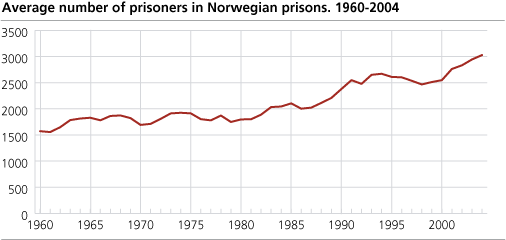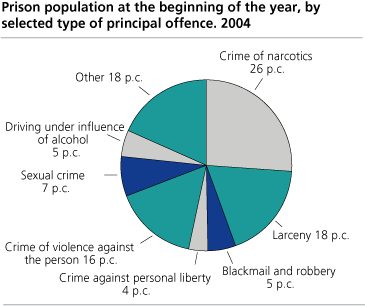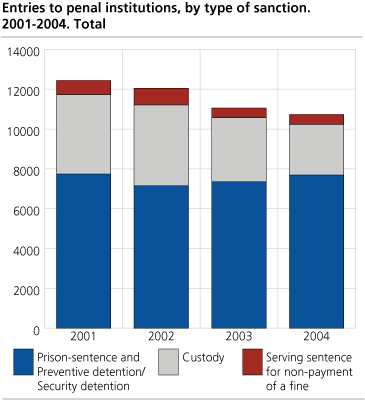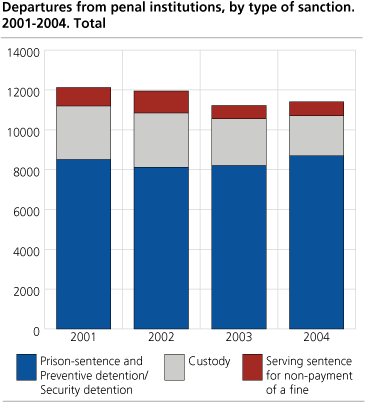Content
Published:
This is an archived release.
More in prison, but less in custody
In 2004, the average prison population in Norway exceeded 3 000 for the first time. This is an increase of 3 per cent from the previous year - and 21 per cent more than five years ago. On the contrary, the number of imprisonment to custody is further reduced.
On an average day in 2004, 2 290 persons served prison sentences, 72 were on preventive detention/security detention, 618 were in custody and 47 were serving sentences for non-payment of a fine. Compared to the previous year, 4 per cent more persons were serving prison sentences and preventive detention/security detention. The average number of prisoners in custody on the contrary, decreased by 4 per cent from the previous year, and is reduced by 7 per cent since 2002. Those serving sentences for non-payment of a fine spent 17 329 days in prison in 2004, 3 390 more days than the year before.
More for crimes
On 1 January 2004, 2 630 of all prisoners had a crime as principal offence, an increase of 5 per cent from the previous year. Compared to 2001, there are 24 per cent more serving in prison for one or more crimes. A little more than 200 had one or more misdemeanours as principal offences, 17 per cent more than in 2003.
For most prisoners narcotic crime (27 per cent), crime of violence1(20 per cent) or larceny (18 per cent) were the principal offence. Those imprisoned for sexual crimes (7 per cent), blackmailing and robbery (5 per cent) and driving under the influence of alcohol (5 per cent) also represented a considerable share. At the beginning of the year, 128 persons were in prison for murder, where of 19 in custody (see text box).
Less youth, but more elder
From a stable distribution on age the previous two years, the share of prisoners below 30 years of age decreased in 2004. Compared to the previous year there was a decrease of 3 per cent in the number of prisoners under 30 years, while the number of prisoners over 30 years increased by 7 per cent. Those aged 40 and older had the steepest rise, and represented 26 per cent of total prison population. The female share per 1 January has, on the other hand, been stable at 6 per cent in the latest years.
Less use of imprisonment to custody
Even if the prison population increases year by year, the imprisonments to custody has been going down in the period 2002-2004. The number of imprisonments decreased in total by 11 per cent, which is connected to a strong reduction in number of imprisonments to custody. The number of imprisonments to custody was reduced by more than 1 500, while on the other hand, the number of new imprisonments to serving prison sentences increased by 550. The decrease in imprisonment to custody are regarded all age groups and both genders - and is generally for most types of offences in this period.
Compared to the previous year, there were 22 per cent less imprisonments to custody with larceny as principal offence. The corresponding decreases were 29 per cent for violent crimes1 and 14 per cent for narcotic crimes.
In 2004, imprisonments to custody represented one fourth of all imprisonments. This is the smallest share since 1991 - which is the first year with comparable figures. The number of imprisonments to custody in 2004 was historical small too, 25 per cent less than at the beginning of the 1990's.
Two of three discharged after full time
In 2004, there were more than 11 000 discharges from prison, 2 per cent more than the previous year. The number of discharges from custody decreased, while the number of discharges after prison sentences increased. Among the prison sentences, there were 7 per cent more conditional discharges and 6 per cent more definitive discharges. In 2004, two third of all discharged prisoners served full time of their prison sentences.
Nine out of ten are discharged within one year in institution, which is at the same level as in 2003.
Shorter time in custody previous to sentence
When it comes to discharges from custody, 61 per cent were completed within a month, and 81 per cent within two months - which is the same level as the year before. On the other hand, for the transfers from custody to serving a sentence, we see a gradual move towards shorter time in custody, where 48 per cent served less than two months - contrary to 42 per cent the previous year.
|
More with known offence
From Imprisonments 2004 included, sentence on preventive detention/security detention is specified by principal offence. In tables on prison population, new imprisonments and discharges, more prisoners are therefore specified on the different types of offences, in particular sexual- and violent crimes. Preventive detention
The new special sanction preventive detention, compulsory mental health care and compulsory care entered into force January 1s t2002, and was made retrospective so that security sentences can be reopened and reversed to one of the new special sanctions. The special sanctions replaced security detention as special penal measure, but there were still persons serving pursuant to a security detention sanction in 2004. |
| 1 | Total for the Penal Code, chapter 12 (Assaulting public servant), 21 (Crime against the personal liberty) and 22 (Crime of violence against the person). |
Tables
Contact
-
Susanne Fjelldalen
E-mail: susanne.fjelldalen@ssb.no
tel.: (+47) 40 90 26 43
-
Kristin Bergvall
E-mail: kristin.bergvall@ssb.no
tel.: (+47) 92 66 55 13
-
Reid Jone Stene
E-mail: reid.jone.stene@ssb.no
tel.: (+47) 99 02 22 01




